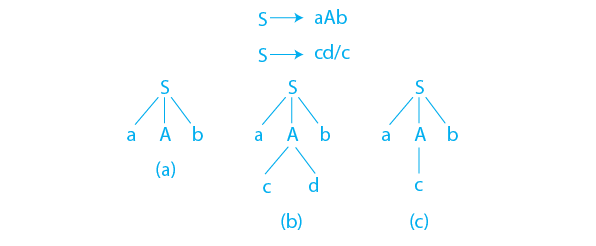Last Updated on July 14, 2023 by Mayank Dham

Top-down parsing in compiler design is a software application included with the compiler, and parsing is a step in the compilation process. Parsing occurs during the compilation’s analysis stage. Parsing is the process of taking code from the preprocessor, breaking it down into smaller pieces, and analyzing it so that other software can understand it.
Parsing
Parsing is the process of converting information from one type to another. The parser is a component of the translator in the organization of linear text structure according to a set of defined rules known as grammar.
Types of the Parser:
Parser is divided into two types:
- Bottom-up parser
- Top-down parser

Bottom-Up Parser
A bottom-up parser is a type of parsing algorithm that starts with the input symbols to construct a parse tree by repeatedly applying production rules in reverse until the start symbol is reached. Bottom-up parsers are also known as shift-reduce parsers because they shift input symbols onto the parse stack until a set of consecutive symbols can be reduced by a production rule.
Top-Down Parser
A top-down parser in compiler design can be considered to construct a parse tree for an input string in preorder, starting from the root. It can also be considered to create a leftmost derivation for an input string. The leftmost derivation is built by a top-down parser. A top-down parser builds the leftmost derivation from the grammar’s start symbol. Then it chooses a suitable production rule to move the input string from left to right in sentential form.
Leftmost derivation:
It is a process of exploring the production rules from left to right and selecting the leftmost non-terminal in the current string as the next symbol to expand. This approach ensures that the parser always chooses the leftmost derivation and tries to match the input string. If a match cannot be found, the parser backtracks and tries another production rule. This process continues until the parser reaches the end of the input string or fails to find a valid parse tree.
Example of Top-Down Parsing
Consider the lexical analyzer’s input string ‘acb’ for the following grammar by using left most deviation.
S->aAb
A->cd|c
Classification of the Top-Down Parser:
Top-down parsers can be classified based on their approach to parsing as follows:

- Recursive-descent parsers: Recursive-descent parsers are a type of top-down parser that uses a set of recursive procedures to parse the input. Each non-terminal symbol in the grammar corresponds to a procedure that parses input for that symbol.
- Backtracking parsers: Backtracking parsers are a type of top-down parser that can handle non-deterministic grammar. When a parsing decision leads to a dead end, the parser can backtrack and try another alternative. Backtracking parsers are not as efficient as other top-down parsers because they can potentially explore many parsing paths.
- Non-backtracking parsers: Non-backtracking is a technique used in top-down parsing to ensure that the parser doesn’t revisit already-explored paths in the parse tree during the parsing process. This is achieved by using a predictive parsing table that is constructed in advance and selecting the appropriate production rule based on the top non-terminal symbol on the parser’s stack and the next input symbol. By not backtracking, predictive parsers are more efficient than other types of top-down parsers, although they may not be able to handle all grammar.
- Predictive parsers: Predictive parsers are top-down parsers that use a parsing to predict which production rule to apply based on the next input symbol. Predictive parsers are also called LL parsers because they construct a left-to-right, leftmost derivation of the input string.
Advantages of Top-Down Parsing
- Top-down parsing is much simple.
- It is incredibly easy to identify the response action of the top-down parser.
Disadvantages of Top-Down Parsing
- Top-down parsing cannot handle left recursion in the grammar’s present.
- When using recursive descent parsing, the parser may need to backtrack when it encounters a symbol that does not match the expected token. This can make the parsing process slower and less efficient.
Conclusion
In conclusion, top-down parsing is a powerful technique for parsing context-free grammar that can be very efficient, especially with the use of predictive parsing. However, its effectiveness depends on the grammar being used, and it may not be suitable for all types of grammar.
Frequently Asked Questions(FAQ)
1. What is a top-down parser?
A top-down parser is a parsing technique that starts with the highest-level grammar rule and recursively expands the rule until the input string is parsed.
2. What are the advantages of using a top-down parser?
Some advantages of using a top-down parser include ease of implementation, the ability to handle ambiguous grammar, and the ability to provide meaningful error messages.
3. What are the types of top-down parsers?
The two main types of top-down parsers are recursive descent parsers and predictive parsers.
4. What is a recursive descent parser?
A recursive descent parser is a type of top-down parser that implements each grammar rule as a separate function, with each function calling other functions to handle sub-rules.
5. What is a predictive parser?
A predictive parser is a type of top-down parser that uses a parsing table to predict which grammar rule to apply next based on the current input symbol and the lookahead symbols.
6. What is LL parsing?
LL parsing refers to a class of top-down parsers that use left-to-right scanning of the input string and the leftmost derivation of the grammar rules.


